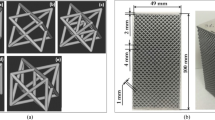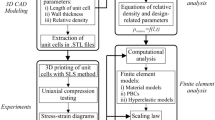Abstract
Additive manufacturing (AM) techniques such as selective laser melting (SLM) enable the fabrication of complex metallic lattice structures. By tuning geometric and topological parameters, these structures can be manufactured to exhibit a range of useful properties, including excellent strength-to-weight ratios and energy absorption capabilities. While the effects of these parameters on various aspects of AM lattice performance have been previously studied, such as the effects of manufacturability, material selection and geometric parameters on the quasi-static performance of AM lattice structures, the effect of topology on the dynamic behaviour of SLM AlSi10Mg lattice structures remains relatively unexplored. Lattice structure specimens with five different topologies were manufactured using SLM AlSi10Mg and tested under quasi-static and dynamic loading conditions. The tested topologies were body-centred cubic with (BCCZ) and without (BCC) z-struts; face-centred cubic with (FCCZ) and without (FCC) z-struts; and body and face-centred cubic with z-struts (FBCCZ). A numerical model was developed to investigate failure modes and collapse mechanisms. Specimens were found to fail by the emergence of diagonal shear planes, and the orientation of which was dependent on topology, due to the uneven concentration of stress in struts across the structure. No significant rate sensitivity was identified for any of the tested topologies in the range of tested strain rates. The FCCZ topology was demonstrated to provide the greatest efficiency in terms of both strength-to-weight and stiffness-to-weight ratios. These results assist in the characterisation of the dynamic behaviour of SLM AlSi10Mg lattice structures and contribute to their further commercialisation.















Similar content being viewed by others
Availability of data and material
The raw/processed data required to reproduce these findings cannot be shared at this time as the data also forms part of an ongoing study.
Code availability
The code required to reproduce these findings cannot be shared at this time as the data also forms part of an ongoing study.
References
Ahuja B, Karg M, Schmidt M (2015) Additive manufacturing in production: challenges and opportunities. International Society for Optics and Photonics
Yan C et al (2014) Evaluation of light-weight AlSi10Mg periodic cellular lattice structures fabricated via direct metal laser sintering. J Mater Process Technol 214(4):856–864
Gibson LJ, Ashby MF (1997) Cellular solids: structure and properties. Cambridge University Press, Cambridge
Murr LE et al (1917) Next-generation biomedical implants using additive manufacturing of complex, cellular and functional mesh arrays. Philos Trans R Soc A Math Phys Eng Sci 2010(368):1999–2032
Hao Z et al (2018) Lightweight structure of a phase-change thermal controller based on lattice cells manufactured by SLM. Chin J Aeronaut
Wang Y et al (2018) Design of graded lattice structure with optimized mesostructures for additive manufacturing. Mater Des 142:114–123
Yavari SA et al (2015) Relationship between unit cell type and porosity and the fatigue behavior of selective laser melted meta-biomaterials. J Mech Behav Biomed Mater 43:91–100
Leary M et al (2018) Inconel 625 lattice structures manufactured by selective laser melting (SLM): mechanical properties, deformation and failure modes. Mater Des 157:179–199
Xiong J et al (2015) Advanced micro-lattice materials. Adv Eng Mater 17(9):1253–1264
Mazur M et al (2017) 5 - Mechanical properties of Ti6Al4V and AlSi12Mg lattice structures manufactured by selective laser melting (SLM). In: Brandt M (ed) Laser Additive Manufacturing. Woodhead Publishing, pp 119–161
Schaedler TA et al (2011) Ultralight metallic microlattices. Science 334(6058):962–965
Hao L et al. Design and additive manufacturing of cellular lattice structures
Liu C et al (2017) Additive manufacturing-oriented design of graded lattice structures through explicit topology optimization. J Appl Mech 84(8):081008
Ashby MF, Medalist RM (1983) The mechanical properties of cellular solids. 14(9):1755–1769
Yan C et al (2012) Evaluations of cellular lattice structures manufactured using selective laser melting. Int J Mach Tools Manuf 62:32–38
Leary M et al (2016) Selective laser melting (SLM) of AlSi12Mg lattice structures. Mater Des 98:344–357
Koehnen P et al (2018) Mechanical properties and deformation behavior of additively manufactured lattice structures of stainless steel. Mater Des 145:205–217
Yavari SA et al (2013) Fatigue behavior of porous biomaterials manufactured using selective laser melting. Mater Sci Eng C 33(8):4849–4858
Harris JA, Winter RE, McShane GJ (2017) Impact response of additively manufactured metallic hybrid lattice materials. Int J Impact Eng 104:177–191
Smith M et al (2010) The quasi-static and blast response of steel lattice structures. J Sandwich Struct Mater 13(4):479–501
McKown S et al (2008) The quasi-static and blast loading response of lattice structures. Int J Impact Eng 35(8):795–810
Tancogne-Dejean T, Spierings AB, Mohr D (2016) Additively-manufactured metallic micro-lattice materials for high specific energy absorption under static and dynamic loading. Acta Mater 116:14–28
Ruan D et al (2002) Compressive behaviour of aluminium foams at low and medium strain rates. Compos Struct 57(1):331–336
Maconachie T et al (2019) SLM lattice structures: properties, performance, applications and challenges. Mater Des 108137
Ashby M (1838) The properties of foams and lattices. Philos Trans R Soc A Math Phys Eng Sci 2005(364):15–30
Deshpande VS, Ashby MF, Fleck NA (2001) Foam topology: bending versus stretching dominated architectures. Acta Mater 49(6):1035–1040
Ashby MF (2005) Hybrids to fill holes in material property space. Phil Mag 85(26–27):3235–3257
Brandt M (2016) Laser additive manufacturing: materials, design, technologies, and applications. Woodhead Publishing
Chen W et al (2019) Stiff isotropic lattices beyond the Maxwell criterion. Science Adv 5(9):eaaw1937
Mazur M et al (2016) Deformation and failure behaviour of Ti-6Al-4V lattice structures manufactured by selective laser melting (SLM). Int J Adv Manuf Technol 84(5):1391–1411
Gusarov AV, Kruth JP (2005) Modelling of radiation transfer in metallic powders at laser treatment. Int J Heat Mass Transf 48(16):3423–3434
Maconachie T et al (2020) Effect of build orientation on the quasi-static and dynamic response of SLM AlSi10Mg. Mater Sci Eng A 788:139445
Leary M et al (2019) Mechanical and thermal characterisation of AlSi10Mg SLM block support structures. Mater Des 183:108138
Ashby MF et al (2000) Metal foams: a design guide. Elsevier
Luxner MH, Stampfl J, Pettermann HE (2005) Finite element modeling concepts and linear analyses of 3D regular open cell structures. J Mater Sci 40(22):5859–5866
Smith M, Guan Z, Cantwell W (2013) Finite element modelling of the compressive response of lattice structures manufactured using the selective laser melting technique. Int J Mech Sci 67:28–41
Labeas GN, Sunaric MM (2010) Investigation on the static response and failure process of metallic open lattice cellular structures. Strain 46(2):195–204
Lei H et al (2019) Evaluation of compressive properties of SLM-fabricated multi-layer lattice structures by experimental test and μ-CT-based finite element analysis. Mater Des 169:107685
Guo H et al (2020) Finite element simulation of the compressive response of additively manufactured lattice structures with large diameters. Comput Mater Sci 175:109610
de Galarreta SR, Jeffers JR, Ghouse S (2020) A validated finite element analysis procedure for porous structures. Mater Des 189:108546
Cao X et al (2020) Compression experiment and numerical evaluation on mechanical responses of the lattice structures with stochastic geometric defects originated from additive-manufacturing. Compos B Eng 194:108030
Rosenthal I, Stern A, Frage N (2017) Strain rate sensitivity and fracture mechanism of AlSi10Mg parts produced by selective laser melting. Mater Sci Eng A 682:509–517
Nurel B et al (2018) Split Hopkinson pressure bar tests for investigating dynamic properties of additively manufactured AlSi10Mg alloy by selective laser melting. Addit Manuf 22:823–833
Al-Rubaie KS et al (2020) Machinability of SLM-produced Ti6Al4V titanium alloy parts. J Manuf Process 57:768–786
Uzan NE et al (2018) On the effect of shot-peening on fatigue resistance of AlSi10Mg specimens fabricated by additive manufacturing using selective laser melting (AM-SLM). Addit Manuf 21:458–464
Aboulkhair NT et al (2014) Reducing porosity in AlSi10Mg parts processed by selective laser melting. Addit Manuf 1–4:77–86
Li W et al (2016) Effect of heat treatment on AlSi10Mg alloy fabricated by selective laser melting: microstructure evolution, mechanical properties and fracture mechanism. Mater Sci Eng A 663:116–125
Aboulkhair NT et al (2016) The microstructure and mechanical properties of selectively laser melted AlSi10Mg: the effect of a conventional T6-like heat treatment. Mater Sci Eng A 667:139–146
Maconachie T et al (2020) Effect of build orientation on the quasi-static and dynamic response of SLM AlSi10Mg. Mater Sci Eng A 139445
Giovagnoli M et al (2021) Effect of different heat-treatment routes on the impact properties of an additively manufactured AlSi10Mg alloy. Mater Sci Eng A 802:140671
Tridello A et al (2019) VHCF response of Gaussian SLM AlSi10Mg specimens: effect of a stress relief heat treatment. Int J Fatigue 124:435–443
Sufiiarov V et al (2020) Investigation of accuracy, microstructure and properties of additive manufactured lattice structures. Mater Today Proc 30:572–577
Hazeli K et al (2019) Microstructure-topology relationship effects on the quasi-static and dynamic behavior of additively manufactured lattice structures. Mater Des 176:107826
Jin Y, Qin SJ, Huang Q (2015) Out-of-plane geometric error prediction for additive manufacturing. in 2015 IEEE International Conference on Automation Science and Engineering (CASE). IEEE
Leary M (2017) Surface roughness optimisation for selective laser melting (SLM): accommodating relevant and irrelevant surfaces. Laser additive manufacturing. Elsevier, pp 99–118
Alghamdi A et al (2020) Effect of additive manufactured lattice defects on mechanical properties: an automated method for the enhancement of lattice geometry. Int J Adv Manuf Technol 108:957–971
Alghamdi A et al (2021) Buckling phenomena in am lattice strut elements: a design tool applied to Ti-6AL4V Lb-Pbf. Mater Des 109892
Yang L (2015) Experimental-assisted design development for an octahedral cellular structure using additive manufacturing. Rapid Prototyp J
Leary M et al (2021) 7 - Surface roughness. In: Yadroitsev I et al (eds) fundamentals of laser powder bed fusion of metals. Elsevier, pp 179–213
Lu G, Yu TX (2003) Energy absorption of structures and materials. Elsevier
Deshpande VS, Fleck NA (2000) High strain rate compressive behaviour of aluminium alloy foams. Int J Impact Eng 24(3):277–298
Acknowledgements
The authors would like to acknowledge the financial support from the members of the ARC Training Centre for Lightweight Automotive Structures and from the Australian Research Council (Grant Reference IC160100032), the scientific and technical assistance of the Swinburne University of Technology Impact Engineering Laboratory and the scientific and technical assistance of the RMIT Advanced Manufacturing Precinct.
Funding
Funding for this project was provided by the ARC Training Centre for Lightweight Automotive Structures (ATLAS), Australian Research Council Grant IC160100032.
Author information
Authors and Affiliations
Contributions
Tobias Maconachie: conceptualization; methodology; software; formal analysis; investigation; data curation; writing—original draft; writing—review and editing; visualisation.
Martin Leary: conceptualization; methodology; writing—original draft; writing—review and editing; supervision; project administration; funding acquisition.
Phuong Tran: writing—review and editing; supervision.
Jonathan Harris: writing—review and editing; supervision.
Qiang Liu: writing—review and editing.
Guoxing Lu: resources, project administration, funding acquisition.
Dong Ruan: resources; writing—review and editing; supervision.
Omar Faruque: resources, supervision, project administration, funding acquisition.
Milan Brandt: resources, supervision, project administration, funding acquisition.
Corresponding author
Ethics declarations
Ethics approval
Not applicable.
Consent to participate
Not applicable.
Consent for publication
Not applicable.
Competing interests
The authors declare no competing interests.
Additional information
Publisher's note
Springer Nature remains neutral with regard to jurisdictional claims in published maps and institutional affiliations.
Rights and permissions
About this article
Cite this article
Maconachie, T., Leary, M., Tran, P. et al. The effect of topology on the quasi-static and dynamic behaviour of SLM AlSi10Mg lattice structures. Int J Adv Manuf Technol 118, 4085–4104 (2022). https://doi.org/10.1007/s00170-021-08203-y
Received:
Accepted:
Published:
Issue Date:
DOI: https://doi.org/10.1007/s00170-021-08203-y




